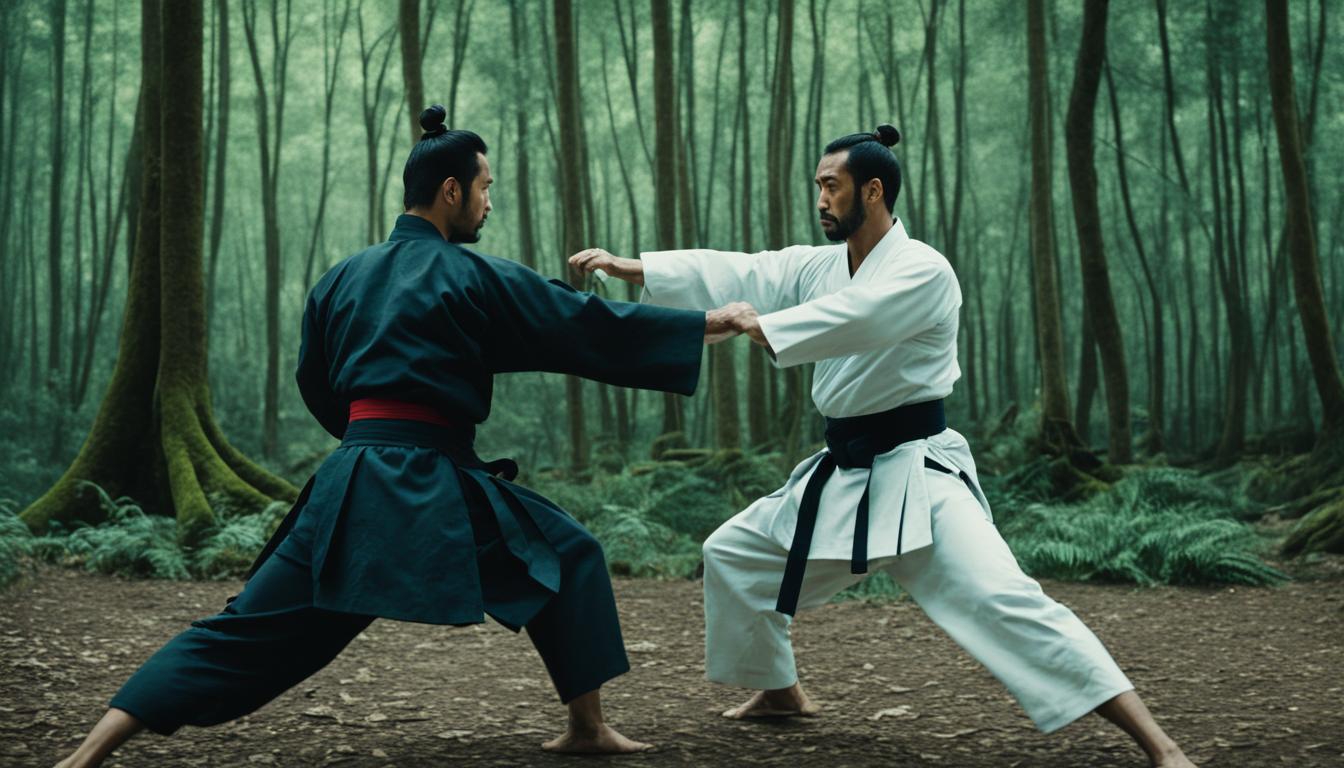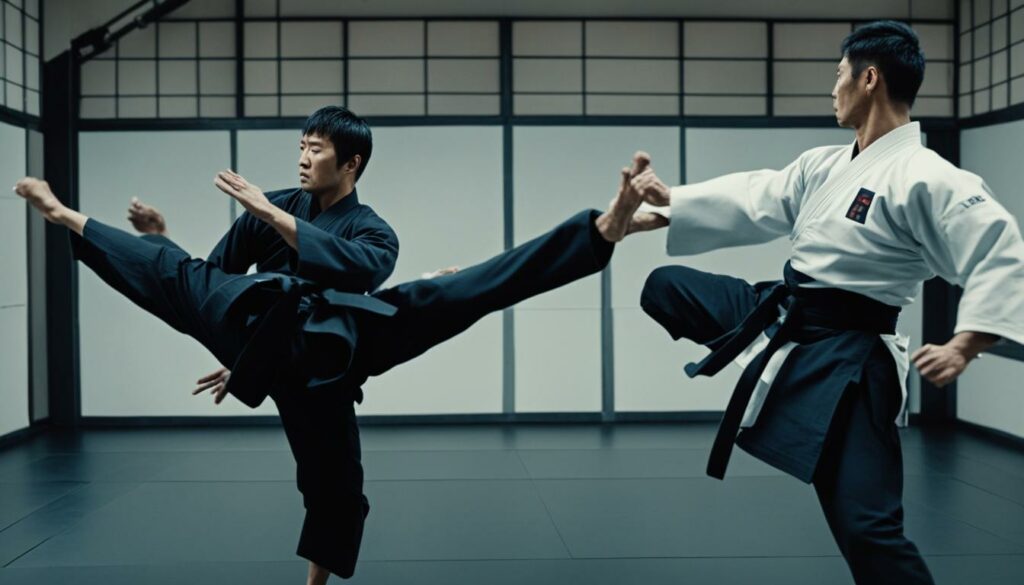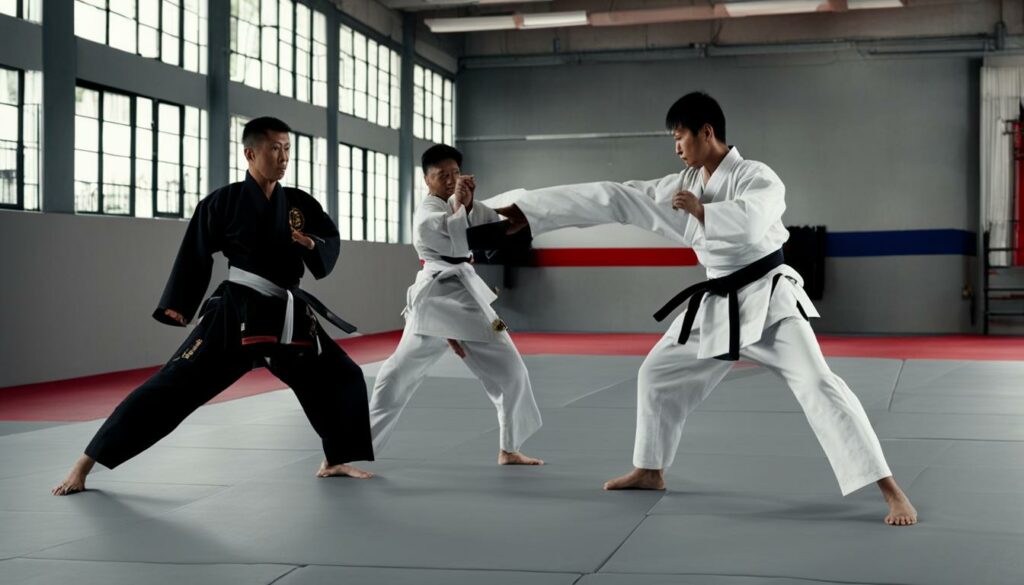Hey there! If you’re interested in martial arts, you’ve probably come across Hapkido and Aikido. They are two fascinating and distinct disciplines that have their own unique characteristics. In this article, I’ll be comparing and contrasting the differences between Hapkido and Aikido, helping you make an informed decision about which martial art is the right fit for you.
So, what sets Hapkido and Aikido apart? Let’s dive in and explore the key differences and similarities between these two martial arts.
Key Takeaways:
- Hapkido and Aikido are both popular martial arts disciplines that offer unique approaches to self-defense and personal development.
- Hapkido was created by Choi Yong Sul in Korea, while Aikido was founded by Morihei Ueshiba in Japan.
- While both arts share a common origin, Hapkido is known for its wider range of techniques, including kicks, strikes, joint locks, and weapon use, while Aikido focuses more on circular movements, energy redirection, and joint locks.
- If you’re looking for a practical self-defense system with a broader range of offensive techniques, Hapkido may be the right choice. Aikido, on the other hand, emphasizes harmony, personal development, and non-violence.
- Both disciplines require dedicated training and practice to develop proficiency, and they offer benefits such as improved physical fitness, self-discipline, self-confidence, and the ability to defend oneself.
Origins and Founders
In this section, we will explore the fascinating history of Hapkido and Aikido, tracing their origins and the visionaries who founded these renowned martial arts disciplines.
Hapkido
Hapkido, the Korean martial art, was developed in the 1950s by the visionary Choi Yong Sul. Born in Korea, Choi Yong Sul was exposed to the Japanese martial art Daito-Ryu Aiki Jujutsu during his time in Japan. He then combined his knowledge of Daito-Ryu with his own experiences and unique techniques, giving birth to Hapkido.
Aikido
Aikido, on the other hand, was founded by Morihei Ueshiba, also known as O-Sensei, in Japan in the 1940s. O-Sensei dedicated his life to the study of various martial arts, including Daito-Ryu Aiki Jujutsu. Inspired by his spiritual beliefs and philosophy, he developed Aikido as a martial art that prioritizes energy redirection, harmony, and non-violence.
Both Hapkido and Aikido have their roots in Daito-Ryu Aiki Jujutsu, but their founders crafted distinct paths for each discipline, resulting in unique philosophies and techniques.
Now that we’ve explored the origins of Hapkido and Aikido, let’s dive deeper into their techniques and philosophies in the next section.
Techniques and Philosophy
When comparing Hapkido and Aikido, it’s important to understand the key techniques and the underlying philosophy behind each martial art.
Hapkido:
Hapkido is known for its wide range of techniques, making it a versatile and comprehensive martial art. In addition to energy redirection and minimal force, Hapkido practitioners also incorporate kicks, strikes, joint locks, and even weapon training into their practice. This diverse range of techniques allows for a more aggressive approach to self-defense, with practitioners being well-equipped to handle various scenarios.
Aikido:
Aikido, on the other hand, focuses on circular and flowing movements. This martial art emphasizes redirecting an opponent’s energy and using joint locks, throws, and pins to neutralize attacks. By blending with an attacker’s movements, Aikido practitioners are able to avoid confrontation and create a harmonious outcome. The emphasis on defense and harmony sets Aikido apart from other martial arts.
While there are similarities in terms of energy redirection and minimal force, the key techniques employed in Hapkido and Aikido differ significantly. Hapkido’s broader range of techniques gives practitioners more options in combat situations, while Aikido’s focus on circular movements promotes fluidity and harmony.
Comparison of Hapkido and Aikido Techniques
| Hapkido | Aikido |
|---|---|
| Kicks | – |
| Strikes | – |
| Joint Locks | ✔ |
| Weapon Training | – |
| Circular Movements | ✔ |
As demonstrated in the table, Hapkido incorporates a wider range of techniques, including kicks, strikes, and joint locks, while Aikido focuses primarily on circular movements and joint locks.
Understanding the philosophies behind Hapkido and Aikido is also essential in fully grasping the differences between the two martial arts.
Hapkido’s philosophy revolves around self-defense and being prepared for real-world combat situations. It emphasizes practicality and aggression, teaching practitioners how to swiftly neutralize threats.
Aikido, on the other hand, places a strong emphasis on defense, harmony, and personal development. It seeks to find a peaceful resolution to conflict by redirecting an opponent’s energy and maintaining balance.
By understanding the techniques and philosophies of Hapkido and Aikido, you can make an informed decision about which martial art aligns best with your goals and preferences.
Self-Defense and Combat Effectiveness
When it comes to self-defense and combat effectiveness, both Hapkido and Aikido offer unique advantages. However, Hapkido is often considered more effective for self-defense due to its broader range of offensive techniques and its emphasis on practical combat scenarios.
Hapkido incorporates a diverse array of techniques, including kicks, strikes, joint locks, and even the use of weapons. With its focus on combative skills, Hapkido equips practitioners with a comprehensive set of tools and strategies to handle real-world confrontations.
On the other hand, Aikido places a higher emphasis on personal development, harmony, and non-violence. While Aikido can still be used as a self-defense system, its primary goal is to redirect and neutralize an opponent’s aggression through circular and flowing movements, joint locks, throws, and pins.
The choice between Hapkido and Aikido ultimately depends on your personal goals and preferences. If you’re seeking a martial art that promotes mental, physical, and spiritual development while placing less emphasis on aggressive combat techniques, Aikido may be the right choice for you.
Alternatively, if your focus is on acquiring self-defense skills and practical combat effectiveness, Hapkido’s broader range of offensive techniques may be more suitable.
Benefits of Practicing Hapkido and Aikido
Both Hapkido and Aikido offer numerous benefits beyond self-defense. Here are some key advantages of practicing these martial arts:
- Improved physical fitness: Regular training in Hapkido or Aikido promotes strength, flexibility, coordination, and endurance.
- Self-discipline: Martial arts training instills discipline, self-control, and perseverance.
- Self-confidence: As you progress in your martial arts journey, you’ll develop confidence in your abilities and gain a sense of empowerment.
- Mental focus: Hapkido and Aikido require mental concentration and can enhance your ability to focus and remain calm under pressure.
Choosing between Hapkido and Aikido ultimately depends on your personal preferences and what you aim to achieve through your martial arts practice. Consider your goals, interests, and the teaching styles of instructors in your area to make an informed decision.
In the next section, we’ll explore training tips and additional benefits of practicing Hapkido and Aikido.
Training Tips and Benefits
Training in both Hapkido and Aikido requires dedication and consistent practice to master the techniques. By training multiple times per week, you can develop proficiency and improve your skills. Regular practice is key to progress and gain a deeper understanding of these martial arts.
- Set a regular training schedule: Block out specific times each week dedicated to your martial arts training. This will help establish a routine and make training a priority in your life.
- Focus on the basics: Mastering the fundamental techniques is crucial in Hapkido and Aikido. Pay attention to detail and practice correct form to build a strong foundation for your training.
- Seek guidance from a qualified instructor: Finding a reputable instructor or school is essential for proper guidance and instruction. A knowledgeable instructor will ensure that you learn the techniques correctly and provide valuable feedback to help you improve.
- Practice with a training partner: Working with a training partner allows you to apply techniques in a realistic setting. Take turns playing the role of the attacker and defender to enhance your skills and understanding of the techniques.
- Train both physically and mentally: Hapkido and Aikido are not solely physical disciplines. They also require mental focus and discipline. Incorporate meditation or mindfulness exercises into your training routine to develop a deeper connection between your mind and body.
Practicing Hapkido and Aikido offers numerous benefits for both your mind and body. Let’s take a look at some of the key benefits.
- Improved physical fitness: Training in Hapkido and Aikido helps improve strength, flexibility, coordination, and balance. The dynamic movements and techniques challenge your body and contribute to overall physical fitness.
- Self-discipline and self-control: Martial arts training instills discipline and self-control. Following a training regimen, practicing techniques, and respecting your instructors and training partners all contribute to developing discipline and self-control.
- Boosted self-confidence: As you progress in your training, overcome challenges, and master techniques, your self-confidence grows. This newfound confidence extends beyond the dojo into other areas of your life.
- Self-defense skills: Both Hapkido and Aikido provide practical self-defense techniques that can be applied in real-life situations. Training in these martial arts equips you with the knowledge and skills to protect yourself if needed.
- Stress relief and mental well-being: Engaging in martial arts training releases endorphins and reduces stress. The focus required during training helps clear the mind, promoting mental clarity and overall well-being.
Remember, finding a reputable instructor or school that aligns with your goals and provides a supportive learning environment is crucial for your training journey. So, lace up your training shoes, find a qualified instructor, and embark on the fulfilling path of Hapkido or Aikido.
Conclusion
In conclusion, Hapkido and Aikido are two distinct martial arts that offer different approaches and benefits. While there are similarities in their approach to energy redirection and defense, the techniques, aggressiveness, and focus of the two arts set them apart.
If you are looking for a martial art that offers a practical self-defense system, Hapkido may be the right choice for you. With its wider range of techniques, including kicks, strikes, joint locks, and weapon training, Hapkido provides a comprehensive skill set for real-world combat scenarios.
On the other hand, if you are seeking a holistic martial art that emphasizes harmony, personal development, and non-violence, Aikido may be more suitable. Aikido focuses on circular and flowing movements, energy redirection, and joint locks, providing a graceful and effective approach to self-defense.
The choice between Hapkido and Aikido ultimately depends on your personal goals, priorities, and preferences. Consider what you are looking to achieve through martial arts training and choose the art that aligns with your values and aspirations. Both Hapkido and Aikido offer valuable benefits, whether it’s the practical combat skills of Hapkido or the mental, physical, and spiritual development of Aikido.



